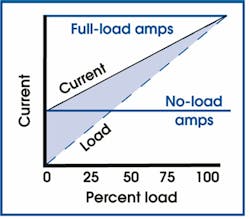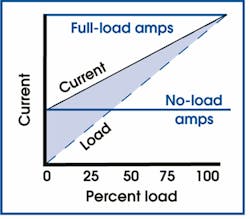Here is a simple method for estimating the actual load on an electric motor without special equipment. But first, a word of caution: Some applications (e.g., a large forced draft fan) require more horsepower (hp) to accelerate the inertia than to drive the load.
The Figure illustrates the relationship between load and current, as well as a fact that’s frequently overlooked. Although the full-load current coincides with the full-load torque, the current at no-load does not equal zero. Ignoring this fact when estimating the size of the motor for an application can be costly. The error is inversely proportional to the load (shaded area), which means the greatest estimation errors will occur when evaluating motors that need replacement the most.
How to estimate motor load
While you can use the graph to estimate a motor’s load, it is more accurate to do so mathematically:
HPrequired = HPnameplate rated x [1 - (FLA - actual current) ÷ (FLA - NLC)]
Where: HP = horsepower, FLA = full load amps, NLC = no-load current
For example, let's say you have a motor with a 100 HP rating and FLA of 120A on an application with a no load current of (NLC) of 35A and actual load current of 100A. Plugging these values into the above equation yields the following required horsepower value.
HPrequired = 100 x [ 1 - (120 - 100) ÷ (120 - 35) ] = 76.5 HP
To approximate the actual load, run the motor uncoupled and record the no-load current. Do not take shortcuts here! If you run the motor coupled but “unloaded,” the value obtained will be wrong. Driving an unloaded pump, conveyor, or fan still takes some torque, so your estimation of hp load won’t be correct. You must use the actual uncoupled current to obtain accurate results.
Because an undersized motor presents another set of problems, make sure you record the load current at the highest load of the process.
Why should you care?
Some utilities impose a charge for poor power factor when a motor is seriously under-utilized. Adding insult to injury, cyclical power users may also be hit with a demand charge based on peak usage. Starting one large, oversized motor across-the-line can increase your cost of electricity for the entire billing period. By identifying and replacing oversized motors, you can reduce utility charges for low power factor and possibly prevent demand charges. The cost savings, for some users, can be significant.
Yung is a senior technical support specialist at the Electrical Apparatus Service Association (EASA) in St. Louis.
About the Author
Chuck Yung
Senior Technical Support Specialist
Yung is a senior technical support specialist for the Electrical Apparatus Service Association (EASA). He is also a Senior Member of IEEE, and is currently chair of their IEEE 1068 working group. He has been involved in the rotating equipment repair industry since 1974. Yung has authored more than 130 technical papers, including several published in the IEEE Industry Applications magazine.

